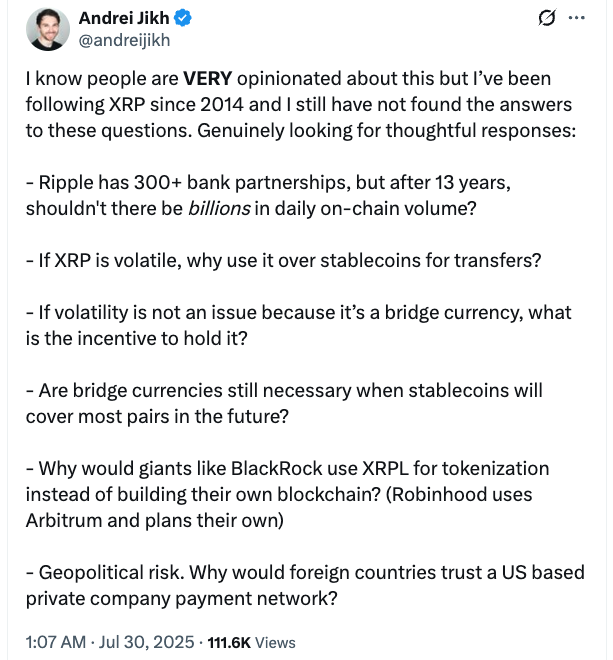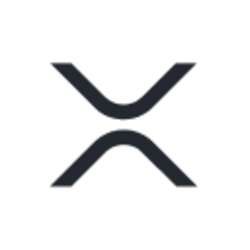Ripple’s XRP Ledger (XRPL) on-chain activity declined by 30–40% in early 2025, raising transparency concerns despite Ripple’s claim of over 300 bank partnerships, as most institutional transactions reportedly occur off-chain.
-
XRPL on-chain metrics show reduced wallet creation and transaction volume in Q1 2025.
-
Ripple CTO David Schwartz explains institutional preference for off-chain transactions due to regulatory concerns.
-
Ripple plans to evolve its XRP Markets Report, emphasizing ongoing transparency through official channels.
Ripple’s XRPL on-chain activity drops 30-40% amid transparency questions; discover institutional off-chain trends and Ripple CTO insights in this detailed report.
Ripple CTO Addresses Slow On-Chain Adoption and Transparency Issues
Ripple’s Chief Technology Officer, David Schwartz, acknowledged that institutional adoption of on-chain transactions on the XRP Ledger has been slow. He emphasized that many institutions prefer off-chain transactions due to concerns over regulatory compliance and potential misuse, such as terrorism financing. Schwartz highlighted that Ripple itself does not rely on decentralized exchange (DEX) transactions on XRPL, reflecting broader industry caution.
How Does Ripple Explain Institutional Off-Chain Usage?
Schwartz explained that institutions historically favored off-chain digital asset use because it offers greater control and privacy. He noted that Ripple is exploring solutions like “permissioned domains” to mitigate risks associated with on-chain liquidity providers. However, he admitted that concrete on-chain adoption remains limited, though momentum may increase as institutions recognize the benefits of blockchain transparency and efficiency.

Source: Andrei Jikh
What is the XRP Ledger (XRPL) and Its Current Scale?
The XRPL, launched in 2012, is an open-source, decentralized blockchain powering the XRP cryptocurrency. Marketed as a “decentralized public blockchain built for business,” XRPL supports various enterprise partnerships, including recent tokenization projects with the Dubai government and Guggenheim investment firm. Despite these collaborations, transparent on-chain metrics remain scarce, complicating assessments of actual network usage.
How Does XRPL Compare in Decentralized Finance (DeFi)?
According to platforms like DefiLlama, total value locked (TVL) on XRPL DeFi applications stands at approximately $81.8 million as of mid-2024. Ripple’s Schwartz clarified that most institutional activity occurs off-chain, which explains the relatively low on-chain TVL. This off-chain preference limits the visibility of XRPL’s true institutional adoption through conventional blockchain analytics.

XRPL metrics and TVL chart from May 2024. Source: DeFiLlama
Why Did XRPL On-Chain Activity Decline by 30–40% in Q1 2025?
Ripple officially reported a 30–40% decline in new wallet creation and transaction volume on the XRPL during the first quarter of 2025. This contraction aligns with similar activity drops observed across major blockchains like Bitcoin and Ethereum. Ripple’s Q1 XRP Markets Report highlighted that while overall activity decreased, decentralized exchange volume on XRPL only fell by 16%, indicating relative resilience in DeFi segments.

An excerpt from Ripple’s Q1 2025 XRP Markets Report released on May 6, 2025. Source: Ripple
What Changes Are Coming to Ripple’s XRP Markets Report?
Starting Q2 2025, Ripple announced it will sunset the XRP Markets Report in its current format. The company plans to evolve its reporting approach, promising continued transparency through official Ripple and RippleXDev channels. Ripple anticipates that as institutional engagement with XRP grows, new insights and perspectives will emerge to enrich market understanding.
What Does This Mean for XRP and Institutional Adoption?
This shift suggests Ripple’s commitment to adapting its communication strategies to better reflect evolving market dynamics. While on-chain metrics currently show reduced activity, Ripple’s emphasis on off-chain institutional use and forthcoming reporting enhancements indicate ongoing efforts to build trust and clarity around XRP’s role in the financial ecosystem.
Frequently Asked Questions
What factors contribute to Ripple’s off-chain institutional adoption?
Institutions prefer off-chain transactions on Ripple’s network due to regulatory concerns, privacy needs, and risks like terrorism financing, which limit on-chain usage despite Ripple’s growing partnerships.
How does Ripple plan to enhance XRPL transparency?
Ripple will update its XRP Markets Report format and continue sharing relevant information through official Ripple channels to improve market transparency and stakeholder trust.
Key Takeaways
- XRPL on-chain activity declined 30-40% in Q1 2025: Reflecting broader blockchain market trends.
- Institutional use remains largely off-chain: Due to regulatory and compliance concerns.
- Ripple commits to evolving transparency reports: Enhancing insights via official communication channels.
Conclusion
Ripple’s recent decline in XRPL on-chain activity highlights the challenges of institutional blockchain adoption amid regulatory scrutiny. While off-chain usage dominates, Ripple’s evolving reporting and commitment to transparency aim to strengthen trust and demonstrate XRP’s growing role in enterprise finance. Continued innovation and clearer data will be key to advancing XRPL’s market position.
